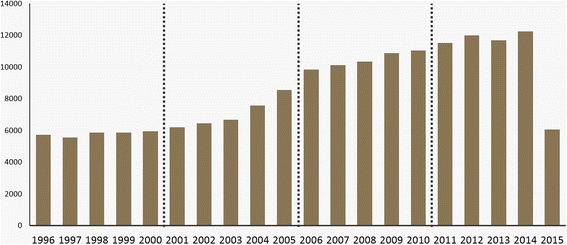Difference between revisions of "Template:Article of the week"
Shawndouglas (talk | contribs) (Updated article of the week text.) |
Shawndouglas (talk | contribs) (Updated article of the week text.) |
||
| Line 1: | Line 1: | ||
<div style="float: left; margin: 0.5em 0.9em 0.4em 0em;">[[File: | <div style="float: left; margin: 0.5em 0.9em 0.4em 0em;">[[File:Fig2 Heo BMCBioinformatics2017 18.gif|240px]]</div> | ||
'''"[[Journal: | '''"[[Journal:Analyzing the field of bioinformatics with the multi-faceted topic modeling technique|Analyzing the field of bioinformatics with the multi-faceted topic modeling technique]]"''' | ||
[[Bioinformatics]] is an interdisciplinary field at the intersection of molecular biology and computing technology. To characterize the field as a convergent domain, researchers have used bibliometrics, augmented with text-mining techniques for content analysis. In previous studies, Latent Dirichlet Allocation (LDA) was the most representative topic modeling technique for identifying topic structure of subject areas. However, as opposed to revealing the topic structure in relation to metadata such as authors, publication date, and journals, LDA only displays the simple topic structure. | |||
In this paper, we adopt the Author-Conference-Topic (ACT) model of Tang ''et al.'' to study the field of bioinformatics from the perspective of keyphrases, authors, and journals. The ACT model is capable of incorporating the paper, author, and conference into the topic distribution simultaneously. To obtain more meaningful results, we used journals and keyphrases instead of conferences and the bag-of-words. For analysis, we used PubMed to collect forty-six bioinformatics journals from the MEDLINE database. We conducted time series topic analysis over four periods from 1996 to 2015 to further examine the interdisciplinary nature of bioinformatics. ('''[[Journal:Analyzing the field of bioinformatics with the multi-faceted topic modeling technique|Full article...]]''')<br /> | |||
<br /> | <br /> | ||
''Recently featured'': | ''Recently featured'': | ||
: ▪ [[Journal:Intervene: A tool for intersection and visualization of multiple gene or genomic region sets|Intervene: A tool for intersection and visualization of multiple gene or genomic region sets]] | |||
: ▪ [[Journal:Users’ perspectives on a picture archiving and communication system (PACS): An in-depth study in a teaching hospital in Kuwait|Users’ perspectives on a picture archiving and communication system (PACS): An in-depth study in a teaching hospital in Kuwait]] | : ▪ [[Journal:Users’ perspectives on a picture archiving and communication system (PACS): An in-depth study in a teaching hospital in Kuwait|Users’ perspectives on a picture archiving and communication system (PACS): An in-depth study in a teaching hospital in Kuwait]] | ||
: ▪ [[Journal:Effective information extraction framework for heterogeneous clinical reports using online machine learning and controlled vocabularies|Effective information extraction framework for heterogeneous clinical reports using online machine learning and controlled vocabularies]] | : ▪ [[Journal:Effective information extraction framework for heterogeneous clinical reports using online machine learning and controlled vocabularies|Effective information extraction framework for heterogeneous clinical reports using online machine learning and controlled vocabularies]] | ||
Revision as of 14:43, 8 August 2017
"Analyzing the field of bioinformatics with the multi-faceted topic modeling technique"
Bioinformatics is an interdisciplinary field at the intersection of molecular biology and computing technology. To characterize the field as a convergent domain, researchers have used bibliometrics, augmented with text-mining techniques for content analysis. In previous studies, Latent Dirichlet Allocation (LDA) was the most representative topic modeling technique for identifying topic structure of subject areas. However, as opposed to revealing the topic structure in relation to metadata such as authors, publication date, and journals, LDA only displays the simple topic structure.
In this paper, we adopt the Author-Conference-Topic (ACT) model of Tang et al. to study the field of bioinformatics from the perspective of keyphrases, authors, and journals. The ACT model is capable of incorporating the paper, author, and conference into the topic distribution simultaneously. To obtain more meaningful results, we used journals and keyphrases instead of conferences and the bag-of-words. For analysis, we used PubMed to collect forty-six bioinformatics journals from the MEDLINE database. We conducted time series topic analysis over four periods from 1996 to 2015 to further examine the interdisciplinary nature of bioinformatics. (Full article...)
Recently featured:
- ▪ Intervene: A tool for intersection and visualization of multiple gene or genomic region sets
- ▪ Users’ perspectives on a picture archiving and communication system (PACS): An in-depth study in a teaching hospital in Kuwait
- ▪ Effective information extraction framework for heterogeneous clinical reports using online machine learning and controlled vocabularies










